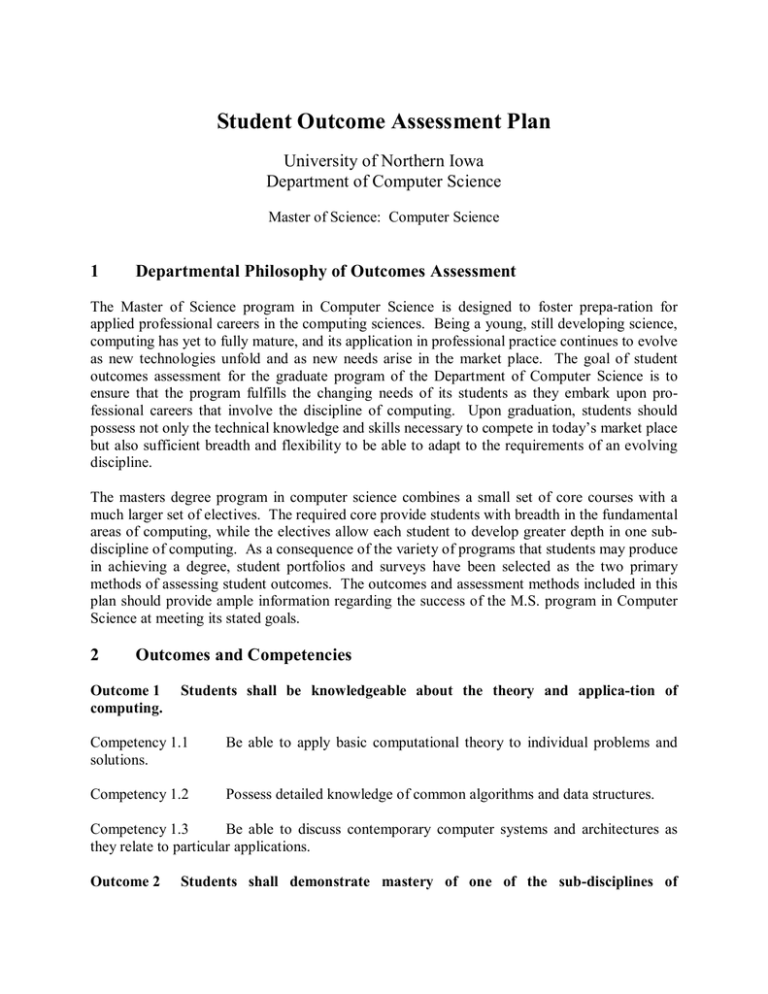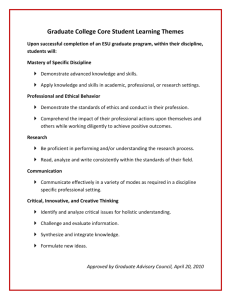Student Outcome Assessment Plan University of Northern Iowa Department of Computer Science 1
advertisement

Student Outcome Assessment Plan University of Northern Iowa Department of Computer Science Master of Science: Computer Science 1 Departmental Philosophy of Outcomes Assessment The Master of Science program in Computer Science is designed to foster prepa­ration for applied professional careers in the computing sciences. Being a young, still developing science, computing has yet to fully mature, and its application in professional practice continues to evolve as new technologies unfold and as new needs arise in the market place. The goal of student outcomes assessment for the graduate program of the Department of Computer Science is to ensure that the program fulfills the changing needs of its students as they embark upon pro­ fessional careers that involve the discipline of computing. Upon graduation, students should possess not only the technical knowledge and skills necessary to compete in today’s market place but also sufficient breadth and flexibility to be able to adapt to the requirements of an evolving discipline. The masters degree program in computer science combines a small set of core courses with a much larger set of electives. The required core provide students with breadth in the fundamental areas of computing, while the electives allow each student to develop greater depth in one sub­ discipline of computing. As a consequence of the variety of programs that students may produce in achieving a degree, student portfolios and surveys have been selected as the two primary methods of assessing student outcomes. The outcomes and assessment methods included in this plan should provide ample information regarding the success of the M.S. program in Computer Science at meeting its stated goals. 2 Outcomes and Competencies Outcome 1 Students shall be knowledgeable about the theory and applica­tion of computing. Competency 1.1 solutions. Be able to apply basic computational theory to individual problems and Competency 1.2 Possess detailed knowledge of common algorithms and data structures. Competency 1.3 Be able to discuss contemporary computer systems and architectures as they relate to particular applications. Outcome 2 Students shall demonstrate mastery of one of the sub­disciplines of computing. Competency 2.1 methodologies. Be familiar with the sub­discipline’s basic principles, open questions, and Competency 2.2 Be conversant in topics of contemporary importance to the sub­discipline. Competency 2.3 Be able to analyze a problem in the sub­discipline, design a solution for it, and build a system that implements the solution. Competency 2.4 Be proficient in the use of at least one programming language commonly used to implement applications in the sub­discipline. Outcome 3 Students shall possess the ability to actively participate in and complete projects of significant size and complexity. Competency 3.1 Be sufficiently familiar with the literature of computing to enable conduct of background research on topics relevant to a project. Competency 3.2 Be able to competently forecast the complexity of a project and the amount of time necessary to complete it. Competency 3.3 lifetime. Be able to manage the complexities of a project over the course of its Outcome 4 Students shall possess the ability to communicate orally and in written form according to the standards of the discipline. Competency 4.1 Be able to make oral presentations appropriate for two kinds of audience: a group of student peers and a group of computing professionals. Competency 4.2 Be able to create written compositions in conformance with the discipline’s standards for technical papers and documentation. Competency 4.3 Be able to create written compositions appropriate for two kinds of audience: a group of student peers and a group of computing professionals. 3 Frequency of Assessments Assessments will occur at five times during each student’s career: • • • • • at the point of admission to the graduate program, once the student has completed the program’s core courses, at the time the student presents a thesis or project proposal, at the time the student completes the thesis or project, and after graduation. The first of these will occur on a continuing basis as students are admitted to the program, at the beginning of each fall and spring semester. The second will typically occur at the end of each spring semester, but some students will complete this phase at the end of fall semester. The third and fourth assessments can occur at any time. Finally, post­graduation assessments will occur each year for a subset of the past student population. 4 Methods of Assessment 4.1 Portfolio The primary mechanism for conducting assessments of the graduate program in computer science major is a student portfolio. When a student is admitted to the program, the portfolio­ based assessment plan will be introduced by the student’s advisor. The advisor will explain the purposes of the assessment portfolio, its intended contents, and the process by which it will be reviewed. The intent is to use the portfolio as a means to plan a comprehensive course of study for each student and as an initial standard by which to evaluate the student’s progress. 4.1.1 Contents of the Portfolio To be added at the point of admission to the program: • The student’s statement of academic and career goals for pursuing graduate study in computer science. • GRE General Examination scores and percentile rankings. • Transcripts from all previous academic institutions. • Letters of reference for admission. • The graduate admissions committee’s Admission Approval Form. To be added upon completion of core courses: • A copy of the student’s graded final examinations from the three core course: 810:240, 810:270, and 810:280. (1.1­1.3) To be added at the time the student presents a thesis or project proposal: • A copy of the student’s program of study. (1.1­1.3 and 2.1­2.2) • A copy of the thesis or project proposal. (2.1­2.2 and 4.2­4.3) • A copy of the Research Proposal Approval Form, signed by all advisory committee members. (2.1­2.2 and 4.1­4.3) • A graded sample of the student’s writing from a course on the pro­gram of study. (4.2­ 4.3) To be added at the time the student completes the thesis or project: • A copy of thesis or project report. (2.1­2.3, 3.1­3.3, and 4.2­4.3) • A copy of the Research Defense Approval Form, signed by all advisory committee members. This form will indicate the student’s performance in both the public and committee portions of the defense. (2.1­2.4 and 4.1­4.3) • A copy of the Research Completion Approval Form, signed by all advisory committee members. (2.1­2.4, 3.1­3.3, and 4.1­4.3) • A listing of the software created as a part of the thesis or project. (2.3­2.4) 4.1.2 Process of Portfolio Accumulation The graduate admissions committee is responsible for preparing the approval form and placing it, along with the accompanying documents, into the student’s portfolio. The student and the student’s advisor are jointly responsible for placing into the portfolio all items required at the times of completing the core course, proposing a thesis or project, and completing the thesis or project. The graduate coordinator will have the option to withhold endorsement of thesis/project proposal and completion approval forms until the items required by that time are added to the portfolio. In any case, applications to graduate will not be approved by the department until a complete portfolio for the student is assembled. 4.2 Survey of Graduates A second mechanism for assessing student outcomes is a periodic survey of graduates. Each academic year, the department will send a questionnaire to all students who graduated during the academic year five years earlier. This survey will address two issues: • How well has completion of a graduate degree in computer science prepared the individual for his or her position? • What changes in technology and the needs of users should be reflected in changes to our program and curriculum? Data collected from these surveys will be analyzed on a student­by­student basis as well as accumulated into a rolling profile of the program as a whole. 5 Analysis, Interpretation, and Reporting of Results The results of the outcomes assessment process will be analyzed and interpreted in two stages: on a student­by­student basis periodically and on a program­wide basis annually. At the time a student either completes the graduate program or is moved to inactive status, the student’s advisory committee (or the graduate affairs com­mittee, if no advisory committee has been formed yet) will review the portfolio and complete a Portfolio Review Report. This report will include (1) a general assessment of the student’s outcomes and competencies based on material in the portfolio and (2) any recommendations for improving the graduate program based on this assessment. Upon completion, the report will be delivered to the graduate affairs committee. Each fall semester, the graduate affairs committee will examine all Portfolio Review Reports and survey results received during the previous year. The aim of this examination is to assess the state of the program and to evaluate its success in achieving program goals. Upon completion of this examination, the committee will develop a list of changes in regulations, policies, and standards to address identified weaknesses in the program. This list will be reported to the graduate faculty and, upon its approval, incorporated into the practice of the department.

